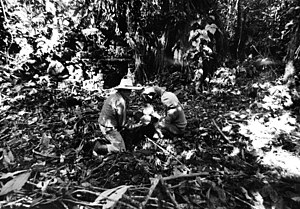Vilcabamba (from Quechua: Willkapampa, "sacred plain") was a city founded by Manco Inca in 1539 and was the last refuge of the Inca Empire until it fell to the Spaniards in 1572, signaling the end of Inca resistance to Spanish rule.
Contents
[hide]
Contents
[hide]History
After the Incan empire fell, the city was burned and the area swiftly became a remote, secluded spot ofPeru. The location of Vilcabamba was forgotten.
The first outsiders in modern times to come to the remote forest site that has since come to be identified with Vilcabamba la Vieja were threeCuzqueños: Manuel Ugarte, Manuel Lopez Torres, and Juan Cancio Saavedra, in 1892. The site of the ruins of the city were then rediscovered by Hiram Bingham in 1911 at the remote forest site 130 kilometres (81 mi) west of Cuzco called Espíritu Pampa, and are written of in his classicLost City of the Incas. Yet, he failed to realize its significance, preferring to believe thatMachu Picchu, which he also rediscovered, was the fabled "Vilcabamba," lost city and last refuge of the Incas. It wasn't until the explorations and discoveries of Antonio Santander Casselli, and Gene Savoy in the 1960s, however, that many came to see this site at Espíritu Pampa as the real Vilcabamba of legend. It was the reporting of the finds of Savoy and his 1970 book, Antisuyo, that brought the site to wider attention. Researcher and author John Hemming provided additional substantive confirmation as to Espíritu Pampa's significance in his 1970 The Conquest of the Incas.
In 1976 Prof. Edmundo Guillen and Polish explorers Tony Halik and Elżbieta Dzikowskacontinued to explore the long-known ruins. However, before the expedition, Guillen visited a museum in Seville where he discovered letters from Spaniards, in which they were describing the progress of the invasion and what they found in Vilcabamba. Comparison between the letters' content and the ruins provided additional proof of the location of Vilcabamba.
In 1981 the party of American explorer Gregory Deyermenjian reached and photographed parts of the site, soon thereafter generating a popular article concerning the site and its history.
Later extensive archeological work by Vincent Lee, and especially his exhaustive study, his 2000 book Forgotten Vilcabamba, gave further and even more precise confirmation that has made Espíritu Pampa the definitively accepted site of the historical Vilcabamba.
On June 16, 2006 a museum in Cuzco[which?] unveiled a plaque that commemorates the thirtieth anniversary of the 1976 Vilcabamba findings.
[edit]In popular culture
The lost city of Vilcabamba features in the educational computer game series The Amazon Trail, the Tomb Raider videogame and its remake Tomb Raider: Anniversary, and the booksEvil Star and Necropolis by British thriller author Anthony Horowitz. Vilcabamba is also a playable place in the PlayStation 2 RPG Shadow Hearts: From the New World.
The city was the location of British writer Colin Thubron's 2002 novel, To the Last City (2002), which was short-listed for the Man Booker Prize, and tells the story of a group of people who set off to explore the ruins of the Inca city [1] in what has been described as a "Heart of Darkness narrative" in a "Marquezian setting."
[edit]Gallery
[edit]See also
[edit]References
- ^ McCrum, Robert (July 28, 2002). "Back to the heart of darkness". The Guardian(London). Retrieved May 27, 2010.





No hay comentarios :
Publicar un comentario